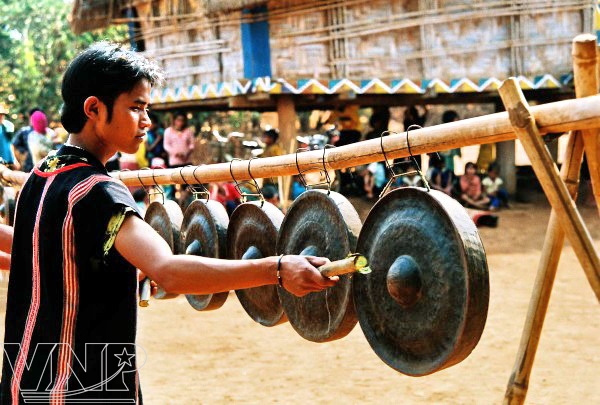It has been six years since the cultural space of gong in Tay Nguyen was recognized as a Masterpiece of the Oral and Intangible Cultural Heritage of Humanity (November 25, 2005) by UNESCO. It is not a long time but enough to have an understanding of this special heritage, particularly in the context when life in Tay Nguyen has experienced great changes.

A gong performance in Tay Nguyen. Photo: Minh Quoc

Small artists performing with gongs. Photo: Hoang Giap

A set of Tay Nguyen gongs. Photo: Kim Son

A gong artist. Photo: Minh Quoc

Foreign tourists discover the art of gong performance in Tay Nguyen. Photo: Minh Quoc |
The cultural space of Tay Nguyen gong spreads over five provinces, including Kon Tum, Gia Lai, Dak Lak, Dak Nong and Lam Dong and the masters of gong culture are the ethnic groups, including Bana, Xedang, Mnong, Caho, Romam, Ede and Giarai. For them, gongs and gong culture present a means to affirm the community and its cultural identities. As time goes by, gongs have become an appealing symbol of the culture of the Central Highlands and an activity associated with the cultural and spiritual life, and the beliefs of ethnic people when they are born, grow up and return to the soil. Gong ensembles are indispensable parts of various ceremonies and festivals, such as the ceremony to pray for the dead soul, new rice ceremony, water trough worshipping ceremony and the buffalo stabbing ceremony. Therefore, the gong culture seems to be mingled into the blood of the highlanders, penetrating into every aspect of their life and majestic epics. The mysterious and powerful sound of gongs is described in the epics as: “Beating gongs to make ghosts absorbed in listening to and forget harming people; make mice forget digging their mouse holes, make snakes lie stiffly; make rabbits start, make deer forget grazing and make all listen attentively to the gongs of Dam San…..”
Despite having outstanding cultural value and being regarded as the privileged language bridging humanity and the supernatural world, it is worrisome that it may fall into oblivion due to the dark sides of modern life and thoughts of local people. The local people may sell their precious sets of gongs due to poverty. The younger generation is no longer interested in learning the traditional art of their ancestors.
To preserve gongs and promote the gong culture, it is necessary for both authorities and people to boost economic development in Tay Nguyen, improve the living standards of local people, protect and collect rare sets of gongs and promote learning about the performance of gongs.
At present, each hamlet in Tay Nguyen has its own gong team to perform at the community’s cultural activities and festivals. Therefore, tourists to Tay Nguyen will have a chance to enjoy different pieces of gong music performed by talented folk artisans.
Story: Giang Khue – Photos: Minh Quoc – Kim Son – Hoang Giap








